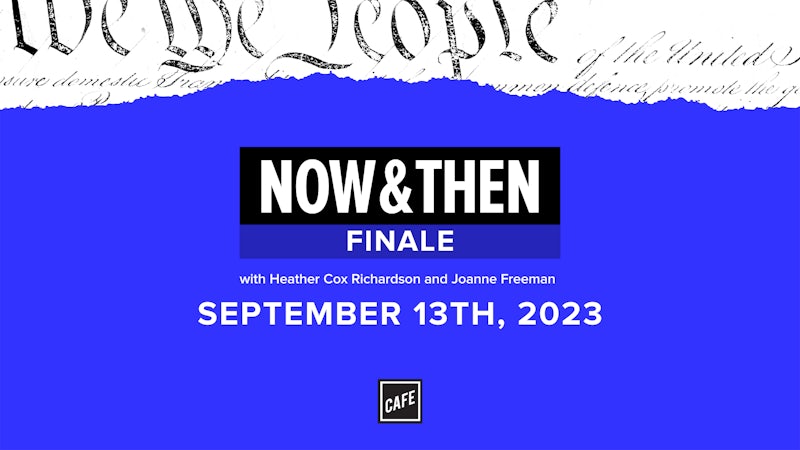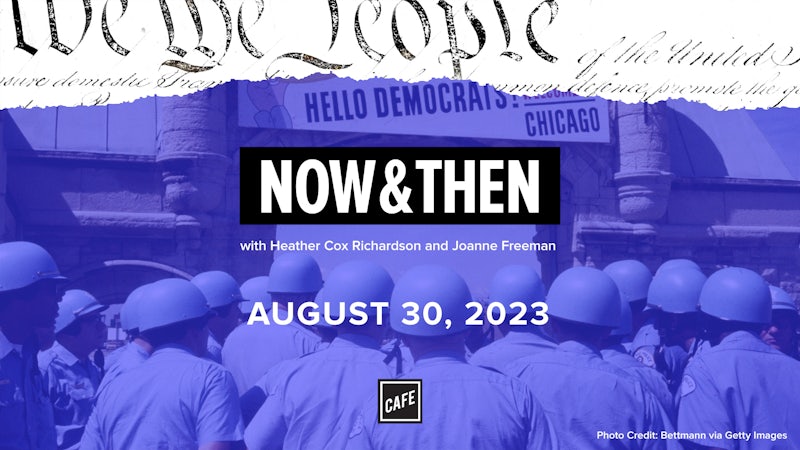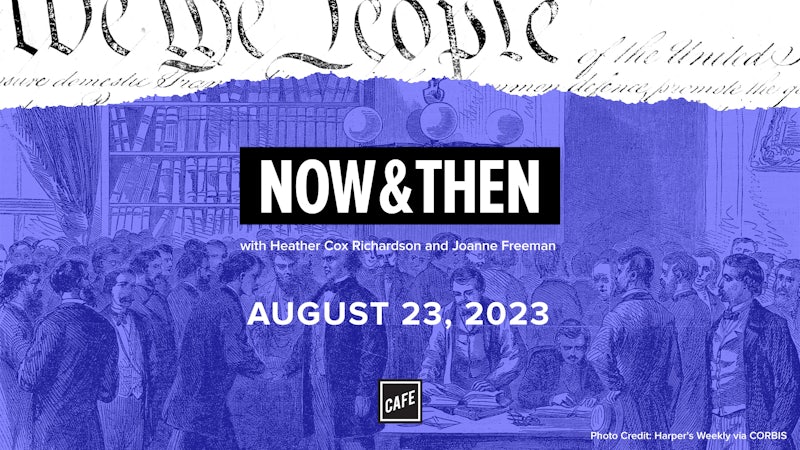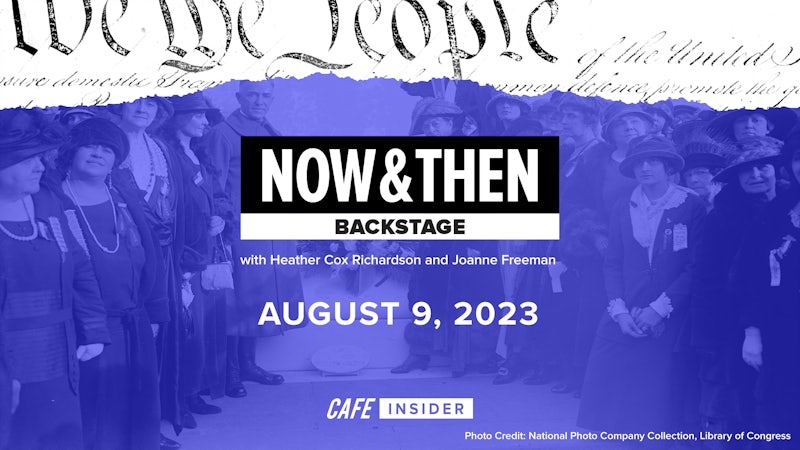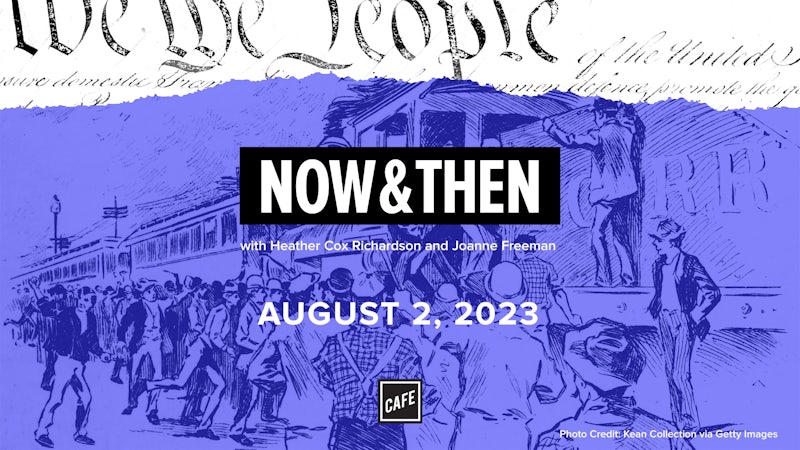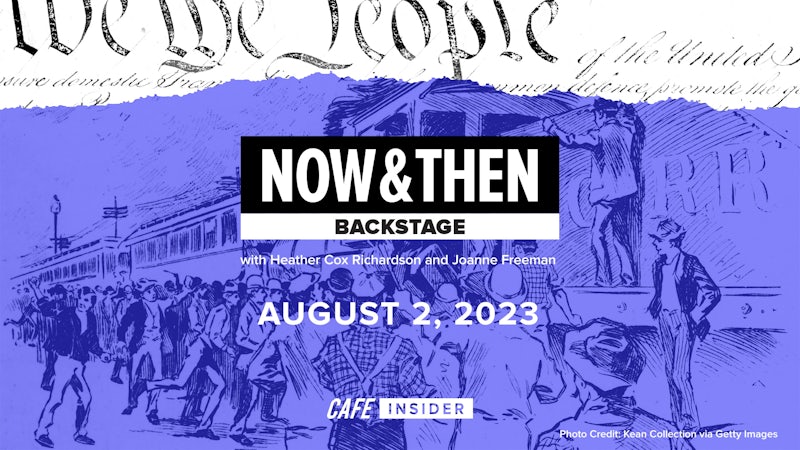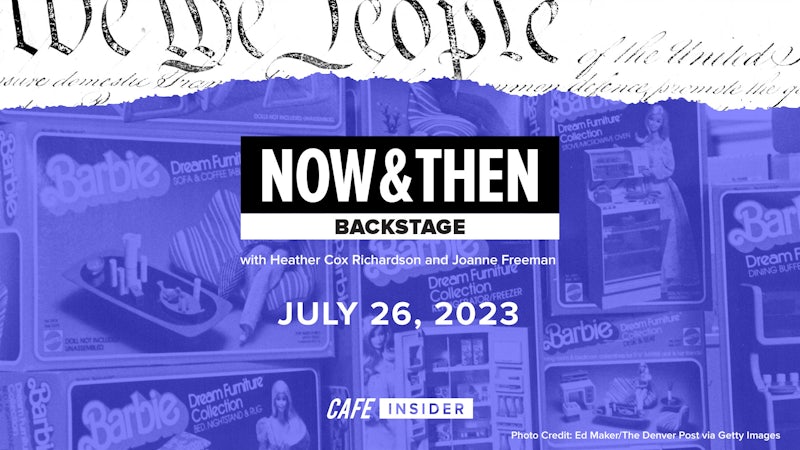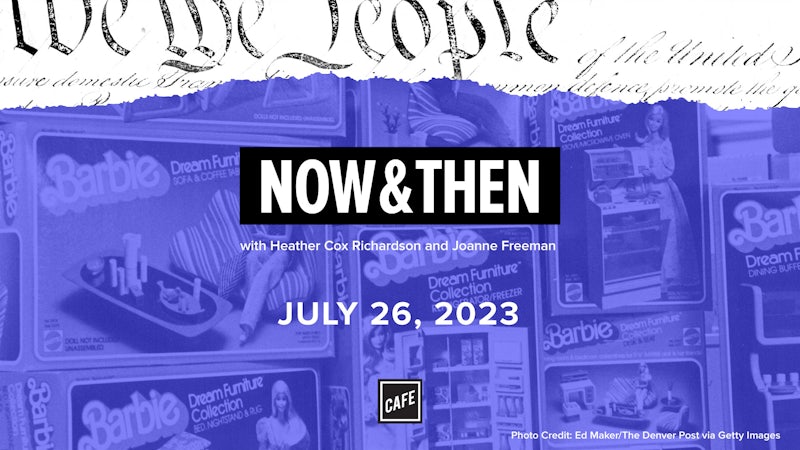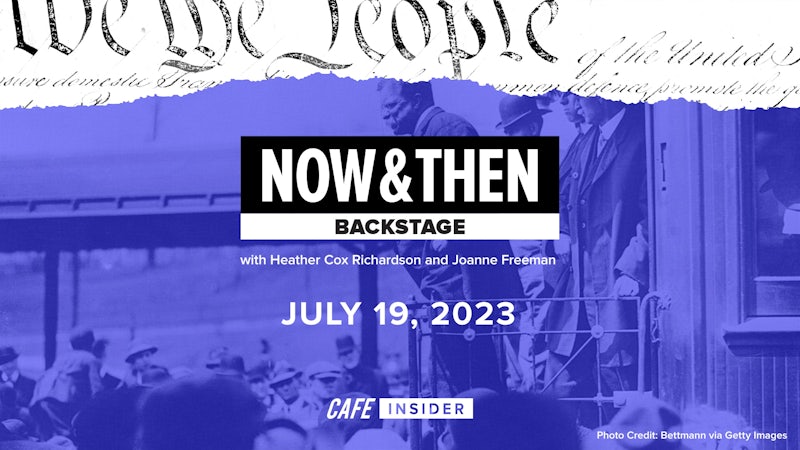Heather Cox Richardson:
From CAFE and the Vox Media Podcast Network. This is Now & Then. I’m Heather Cox Richardson.
Joanne Freeman:
And I’m Joanne Freeman. Heather and I just moments ago were discussing the degree to which people we know are totally obsessed with the Women’s World Cup and watching it and waking up at zero hour in the morning to see what’s going on. We want to talk about the Women’s World Cup, and more broadly we want to talk about women and sport. Obviously, what’s launching us off on this topic today has to do with the recent loss of the American team to Sweden at the Women’s World Cup in Melbourne, Australia and the controversy that arose, how people responded to that loss given the fact that some members of the women’s team remained silent during the national anthem, and the politicization of the loss and the link of not singing the Anthem somehow deserving punishment, and athletes having a political message, and add into that Megan Rapinoe and LGBTQ issues as well.
It became a moment that is very representative of many moments that we’re living through at the moment. So women’s sports, women’s soccer, and the larger meaning of these things as far as American society is concerned, these are some of the things we want to address today.
Heather Cox Richardson:
Well, and it’s a wedge into looking at the way that people in the United States think about women’s issues in this moment. We have talked before about how the national anthem before sports came into being and then is increasingly weaponized. And I will point out that when we first had this apparent controversy over the fact the soccer players weren’t singing to the national anthem, I thought, when did sports people start singing to the national anthem in addition to coming out for the national anthem and now having an issue about whether they’re standing for the national anthem? And this, I think, is less about long-standing tradition than an attempt to attack these particular members of a sports team and what that says about that sports team.
So of course as soon as the American Women’s Soccer Team lost to Sweden, the former President Trump came out on social media and attacked the team itself, but especially Megan Rapinoe, who’s been in a longstanding feud with the former President. Rapinoe is a lesbian and led the team in refusing to visit the White House after the 2019 World Cup win because Trump had taken such a stand against LGBTQ rights. And at the time she did a CNN interview in which she addressed Trump explaining why the team had decided what it had in not visiting the White House. She said,
Megan Rapinoe (archival):
I think that I would say that your message is excluding people. You’re excluding me. You’re excluding people that look like me. You’re excluding people of color. You’re excluding Americans that maybe support you.
Heather Cox Richardson:
Not surprisingly then, when the US Women’s Soccer Team lost to Sweden, Trump gloated and argued that the team’s failure was reflective of a larger downturn in American sports that was somehow a product of President Joe Biden and woke culture. And before I read what he said here, I will point out that the people who are on elite sports teams are the best of the best and they’ve worked incredibly hard to be there. So a loss at that level is not a sign of anybody not being good at what they’re doing or having… I’m a little bit inarticulate on how offensive it is to me when people jump on athletes for being human, when in fact they’ve worked incredibly hard to be where they are. Anyway, Trump said, “The shocking and totally unexpected loss by the US Women’s Soccer Team to Sweden is fully emblematic of what is happening to our once great nation under crooked Joe Biden. Many of our players were openly hostile to America. No other country behaved in such a manner or even close. Woke equals failure. Nice shot Megyn. The US is going to hell. MAGA.”
Joanne Freeman:
Now, Trump wasn’t the only person, not surprisingly, who took that approach. There were any number of other people who followed that line in their criticism of what happened. For example, Fox News soccer commentator Alexi Lalas, who himself is a veteran of the US men’s national team, which I will add never won a World Cup, posted on Twitter an analysis, actually I should say, posted on Twitter (X) an analysis of the loss that again seemed to link the team’s stand for equality and their defeat. He said, “The USWNT is polarizing. Politics, causes, stances, and behavior have made this team unlikeable to a portion of America. This team has built its brand and has derived its power from being the best from winning. If that goes away, they risk becoming irrelevant.” And former Fox News host and right-wing podcaster, Megyn Kelly, went even further saying,
Megyn Kelly (archival):
They donned the uniforms of the United States of America, but they refused to honor anything we stand for and therefore I am thrilled they lost. Good. I’m glad you went down. You don’t support America, I don’t support you. And I know I’m not alone.
Heather Cox Richardson:
But even the fact that there is this much attention paid to this event at the highest levels of media and of the political system suggests that women’s sports is about far more and getting far more attention than it was even 20 years ago.
Joanne Freeman:
There’s an underlying meaning here that says a lot about women and society at this moment, actually women in the world, not just in the United States at this moment. I’m saying that mostly so that we don’t all do what is easy to do because of the extreme language, which is to just go into the place in your brain that’s focused on politicization and extreme language and not go further into the deeper meanings.
Heather Cox Richardson:
In fact, many Americans are paying way more attention than they used to to American’s women’s sports sort of across the board. The NCAA, the National Collegiate Athletic Association College Women Basketball Championship game between LSU and the University of Iowa Hawkeyes on April 2nd in Dallas had an increase of 103% in viewers from last year’s game. People are more and more interested in women’s team sports. I want to emphasize we’re talking about team sports here and not individual sports, which we’ve talked about before. Because again, they say something about how we expect women to behave in our society, and that has always, always been the case. So the emergence of organized women’s sports comes in a really crucial moment that is tied to the rise of the idea that women have roles to play outside the home. So after the Civil War when women are starting to go into what we called for a time, pink collar professions like teaching and nursing, and once families after the 1870s start having more money and more time to invest in their children, women start to go to colleges.
And the rise of women’s colleges creates all kinds of anxiety in society about whether or not women really should be exercising their brains. So one of the earliest things that colleges do is they start to focus on the idea that women who are studying also need to be exercising their muscles. And the initial move toward encouraging women to become athletes came from this idea that otherwise they would become neurasthenic and they’d ruin themselves for productivity by thinking too much. They needed to be more active.
Joanne Freeman:
Don’t want them thinking too much.
Heather Cox Richardson:
Early experiences of women in colleges and early books, popular books about women at women’s colleges, really tend to focus on the idea of women learning to swim or going on long hikes with their colleagues or making sure they went to gymnasium several times a week just so that they wouldn’t keel over from all the Greek that they were learning.
Joanne Freeman:
Now, one of the pivotal figures in changing this is a woman by the name of Senda Berenson, who was actually a gymnastics instructor at Smith College in Massachusetts, all women at the time. In 1892, introduced women’s basketball to the school. Now, Berenson was a Lithuanian Jewish immigrant whose family settled in Boston when she was a young girl in the 1870s, and she was forced to give up her studies at the Boston Conservatory of Music because she had fragile health. And so she ended up enrolling at the Boston Normal School of Gymnastics in 1890 in an attempt to improve her strength. That was her initial motive. Now she really thrived at the Boston Normal School of Gymnastics. She graduated in 1892 and quickly got a position as the director of physical education at Smith. A year before Berenson’s arrival, James Naismith had developed initial rules for basketball while studying at the international YMCA training school in Springfield, Massachusetts, about 20 miles away from Smith.
Berenson heard about Naismith’s new sport and went to Springfield to watch and decided based on that that she wanted to bring basketball back to Smith. Now, she and her students ended up slightly changing the rules. They were a little more limited as far as what women could do. So for example, women players were limited in the zones that they could play in during the game, and they were not permitted to steal the ball. Now, Smith ended up organizing very popular interclass games, and soon after women’s colleges were hosting exhibition games and playing one another. Interestingly, Berenson was not interested in starting up a league and instead focused on bringing other sports to Smith like fencing and golf. She positioned her efforts within a larger goal of making women both physically and mentally healthier. And she explained this in 1894, offering her view on the frailty, or the supposed frailty, of women. She said, “Until recent years, the so-called ideal woman was a small waisted, small footed, small brained damsel, who prided herself on her delicate health, who thought fainting interesting, and hysterics fascinating.”
Heather Cox Richardson:
And this is a crucial moment of pushing back against images. And it’s worth mentioning here, images of upper middle class white women who lived at the time in corsets, for example, which really significantly constricted their internal organs. So they had very, very narrow waists. If you read, for example, Laura Ingalls Wilder boasting about the fact that her father could span her mother’s waist with his hands when they were there married.
Joanne Freeman:
Which is why there was fainting. Because women couldn’t take a full breath because these corsets were pulling them in and literally misshaping their body in the process.
Heather Cox Richardson:
And why they felt as badly as they did as much at the time. And where this is going to go, of course, is that when women are exercising in these women’s colleges, they’re not wearing corsets. They’re wearing clothes that more accurately fit their bodies. And it’s worth pointing out here that there is a trend underway to change the clothing that women wear. Pretty soon the skirts are going to get shorter so that they’re not dragged through the mud so that women can be outside the home more. And within a couple of decades, we’re going to start to see the scandals of things like flappers, women wearing dresses that are not constricting.
Joanne Freeman:
Exposed things.
Heather Cox Richardson:
And that badly hurt the corset industry and also the cloth industry because they need so little fabric. So we’re talking about basketball at Smith, but we are really talking about women’s lives changing so dramatically that they’re going to unseat not only ideas about gender, but also to crucially important industries in the early 20th century. So Berenson justifies her embrace of women’s physical activity with this idea that it’s going to stop them from being mentally overtaxed.
Joanne Freeman:
She made that point in 1900 in a writeup that was reprinted in the New York Tribune. She said, “Women are physically timid, have no self-reliance, are still rather self-conscious and personal. Team games where the individual is secondary to the team, where fair play, earnestness of purpose, and the ability to give one’s best for the good of the cause are developed. Where a slight element of physical danger comes in are especially valuable for the college woman who is expected to make herself felt in whatever calling she may take up.”
Heather Cox Richardson:
Very different than the rise of men’s athletics in the same period, men are supposed to be embracing a sort of savagery on the team and on the field that the proponents of male sports feel is lacking in the rise of the 20th century in the idea that people go to offices and they work in factories. This is supposed to give men much more of a sense of being wild and manly. It’s why we have all those sort of team names that evoke indigenous Americans or evoke some kind of war-like principle. But at the same time, here’s the woman who really initiated team sports saying, oh, this is about learning to cooperate and make a real difference in society.
Joanne Freeman:
And of being able to face some danger of understanding how they can assert themselves. I mean, this is about, as we’ve already said, really has to do with the strength of women and their ability, strength writ large, and their ability to know that and to use that in society at large.
Heather Cox Richardson:
Very well put. So by the turn of the 20th century, basketball for women had gone national, and in 1896, the first intercollegiate basketball championship was held between Stanford and the University of California Berkeley at the Page Street Armory in San Francisco. Stanford won, the crowd was 700 people, all women, because men were not allowed to attend the game. They climbed on the roof to watch it instead.
Joanne Freeman:
But that’s interesting to me because they were interested and they climbed the roof to watch, right? So it could have been easily only women are allowed in, only women went, men had no interest in it, it was a woman’s thing. And that’s not the case even as early as 1896, which I find fascinating,
Heather Cox Richardson:
The San Francisco Chronicle gave the game a glowing review saying, “There is not an instant of ennui in basketball. All is motion, change, and excitement.” And again, think of what this means to have middle class to upper middle class women, white women, which is what they would’ve been, sweating and running in ways that both indicated their own strength, but that also embraced a kind of activity that had previously been associated much more clearly with women in the factories or women in the fields, women who had to live a kind of life that was not something normally that an upper middle class woman would aspire to. Big change there.
Joanne Freeman:
Sweating and running and physically competing and asserting themselves against the other team also in a way that would be for people something very foreign, something that they wouldn’t have seen before. Never mind as part of a team doing that.
Heather Cox Richardson:
So Berenson and her focus on basketball and some of the other things she talked about, golf and fencing and gymnastics, helped to spark a movement. By 1917, the American Physical Education Association formed a committee on women’s athletics. And by 1923, 22% of American colleges had women’s varsity sports teams, and they continued to open up women’s sports that previously had been thought to be too strenuous. So in 1929, for example, Tuskegee University had one of the first women’s track and field teams. Running, throwing things, and even offered scholarships to promising female athletes.
Joanne Freeman:
Which again, if you’re offering a scholarship to a promising woman athlete, you in essence are endorsing that as not a professional endeavor, but as something that you’ve dedicating part of your life to, right? If you say to someone, I’ve won a scholarship for basketball at whatever college, that’s quite a statement for both a woman and the fact that a university is willing to make that kind of a statement, that a female basketball player is a basketball player and not just a woman who happens to play basketball.
Heather Cox Richardson:
But it wasn’t a clear line through to the present, in part because of The Depression and World War II, periods in which the incredible dislocation of American society once again made women who had the opportunity to have aspirations decide that they didn’t necessarily want to be sweating and running and taking on that sort of a role in society. And then after World War II, when women did go into the factories, did work in the fields, did take on societal roles that more often paralleled those of men, we get the backlash to that in the 1940s and the 1950s. The idea that women should be delicate creatures who focused on stereotypical gender roles in American society. So the parallels between American women’s sport and the rise of the second wave of feminism in the 1950s and the 1960s are once again entwined. But that return to the poodle skirt, as I always think of it, changes dramatically again in the 1970s.
Now, this does indeed bring us to the 1970s and the Title IX statute, which offers new federal protections for women amateur athletes and, not surprisingly, opens an entire debate on the best way to secure equal rights for women’s teams.
Heather Cox Richardson:
So just as a start here that I really want to emphasize, Title IX was not about athletics.
Joanne Freeman:
Yeah, it’s very clear when it starts out and the language of it, which is interesting because reading the language of the original Title IX, I didn’t think about what I expected to find or not find, but when I read it and then thought to myself was, oh, it actually isn’t only about athletics. Title IX was a broad-based civil rights act part of the Education Amendments of 1972, and it was designed to outlaw sex discrimination in educational institutions that received federal funding. Democratic Indiana Senator Birch Bayh, long interested in fighting discrimination in women’s education and employment, wrote the text of Title IX, 37 words, and as Heather just suggested, it makes no mention of sports. So this is Title IX, the original Title IX. No person in the United States shall, on the basis of sex, be excluded from participation in, be denied the benefits of, or be subject to discrimination under any educational programs or activity receiving Federal financial assistance.
So it doesn’t mention sports, it does mention educational programs or activities, and that’s as far as it goes. Now, not surprisingly, just given the simple fact that it was proposed and it affects gender inequality and also that it affects sports, some fellow legislators became concerned about the implications of Title IX for the massive men’s college sports market and for collegiate culture. Now, Bayh highlighted that the law did not necessarily mean that men’s and women’s sports classes or dormitories needed to integrate completely or even look exactly the same. He said, “I do not read this as requiring integration of dormitories between the sexes, nor do I feel it mandates the desegregation of football fields. What we are trying to do is provide equal access for women and men students to the educational process and the extracurricular activities in a school.”
Heather Cox Richardson:
But, nonetheless, there was a huge backlash to Title IX from people on the right with legislators insisting that it would uproot college athletics, especially football. In 1974, John Tower sponsored the Tower Amendment, which would’ve exempted most college athletics from the statute. And this is where people get the idea that Title IX was just about sports or was even about sports. The Tower Amendment eventually failed, but the eventual specific athletic guidelines that were unveiled in 1975 and went fully into effect in 1978 did leave some room for athletic programs to be different between the sexes, but highlighted that there should be equal athletic opportunity.
Joanne Freeman:
So, ultimately, there was a stipulation added to Title IX that addressed specifically athletics, and it said, “A recipient which operates or sponsors interscholastic, intercollegiate, club, or intramural athletics shall provide equal athletic opportunity for members of both sexes. In determining whether equal opportunities are available the Director will consider, among other factors: whether the selection of sports and levels of competition effectively accommodate the interests and abilities of members of both sexes. Now, in terms of financial commitments to women’s programs, which of course given the money invested in men’s sports is going to be a big deal, the guidelines stipulated that schools offer substantially equal per capita expenditures for men’s and women’s athletic programs, but that the outlay of money would be dependent on the demand by women athletes for particular programs, and that the big money male sports programs like football would be exempted from spending the same amount of money on women’s programs.
Heather Cox Richardson:
And this is a big thing for a lot of universities where the football programs bring in a lot of money for the schools and cement the ties of older alumni to the school. Believe me, I’m going to start to talk about the sexism here in just a minute, but there is a very serious financial component here for a lot of the universities. And so it’s not surprising that a number of college athletic programs joined right wing legislators in opposing Title IX. In 1975, a lawyer for the National Collegiate Athletic Association said that forcing colleges to spend money on women’s sports could bankrupt athletic programs because they would never recoup the kind of money that had to be laid out on them.
Joanne Freeman:
This had to do with big money, it has to do with alumni, it has to do with getting more big money for the university. The other thing about big money male sports is that in a sense, it ends up being a part of the identity of the institution. Like, my father went to Dartmouth College and taught me all of the Dartmouth College fight songs, which I still know. And that was, for him, it was going to sporting events and singing the songs, and that’s true for alumni of all kinds, not just male alumni. So we’re talking about big money, we’re talking about big money being spent and brought in, and even the very identity of these institutions.
Heather Cox Richardson:
So what happens is that women athletes take a role in pushing forward the implementation of Title IX. And I have to say, I got a letter from one of these women within the last couple of years talking about what happened at Yale in March of 1976 when the women rowers at Yale. Yale had only gone co-ed seven years earlier. You should learn more about the history of Yale, Joanne, because I know you have nothing to do with the place. And they protested the Women’s Rowing Program because the Yale crew coach for the women’s program had been a former male rower, and he was really doing it out of love. He got $500 to coach the women’s crew team at Yale in 1976, and he was working at a foam rubber factory to pay his bills.
The women had the old wooden boats, which were quite heavy, while the men had brand new boats, and pretty soon they would be boats that were made of carbon fiber. So the difference between the weights of the two is really, really a lot. And the women didn’t have access to the boathouse. They had a trailer that had shower heads in it, but no hot water. And then they would have to wait on the bus and then shower when they got back to Yale, but that would mean that they would be sitting there in their wet clothes in this bus waiting for the men to have their showers.
Joanne Freeman:
Waiting for men who were having their hot showers, yeah.
Heather Cox Richardson:
The Yale women’s crew team in this period was among the best of the best, so they were performing far better than the men were in competitions. Two of the women on the team, Christine Ernst and Anne Warner, were part of the team that won the silver medal at the 1975 World Championships. So they organized a meeting with Yale’s director of Women’s Athletics, Joni Barnett. And at the meeting in Barnett’s office, 19 of the women rowers stripped naked to point out that this is what they were asked to do in those showers, and they had Title IX or IX written on their bodies.
And one of the silver metal rowers, Ernst, read a statement to Barnett which said in part, “These are the bodies Yale is exploiting. We have come here today to make clear how unprotected we are. To show graphically what we are being exposed to. On a day like today, the rain freezes on our skin, then we sit on a bus for half an hour as the ice melts into our sweats to meet the sweat that has soaked our clothes underneath. No effective action has been taken, and no matter what we hear, it doesn’t make these bodies warmer or drier or less prone to sickness. We are not just healthy young things in blue and white uniforms who perform feats of strength for Yale in the nice spring weather. We are not just statistics on your win column. We’re human and being treated as less than such.”
Joanne Freeman:
Now, I want to jump in here only because when I read that quote earlier and read what happened, it made me laugh out loud. So that’s powerful. These women made this powerful statement, said something that’s so preaching truth in the most physical way possible, and what happened? They got hot water in the trailer. Now that’s good, but they’re talking about such a sweeping point of view that on the one hand, excellent, no more sitting on the bus in sweaty clothes and waiting for the men while they take their hot showers. They did immediately get hot water in their trailer, and ultimately by 1977, a woman’s locker room was added to the Yale boathouse so that the whole bus sitting problem was eliminated. So women’s athletic groups, and actually echoing Berenson almost a century earlier, also argued that the growth of women’s team sports could be fundamentally transformative for equal rights across the country.
According to Eva Auchincloss, the executive director of the Women’s Sports Foundation in 1978, she said, “I feel strongly that girls aren’t going to be equal until they learn to be physically and mentally strong. One problem is that women like the stamina, agility, and coordination that comes from sports participation, especially participation in team sports, and Title IX provides girls with the opportunity to learn these skills from an early age.” In 1979, right at roughly the same time, a coalition of women’s sports groups held a 250 women march on the White House to encourage the White House to continue enforcing Title IX athletic regulations, and a lot of the marchers were wearing shirts that said Title IX, Hold the Line. And they spoke out against the continued attempts by the National College Athletic Association, the NCAA, and other lobbying groups representing colleges to limit the implementation of Title IX.
Carol Mushier, the president of the Association for Intercollegiate Athletics for Women said, “Congressman tell me they’re hearing only from the NCAA. We need to let them hear from us this week.” And lo and behold, the much feared collapse of college athletics did not come to pass with Title IX. Instead, colleges reworked their budgets to accommodate women’s programs and saw a massive uptick in both women’s participation and public interest in women’s athletics. Immediately before Title IX’s passage, about 30,000 women played college sports. In 2021, around 219,000 women played college sports. So a lot of different things were affected at this moment more broadly about women, about women’s sports, about the attention paid and importance granted to all of these things. So Title IX in many, many ways was about more than athletics.
Heather Cox Richardson:
I vividly remember when Title IX passed, people saying no one’s ever going to care about women’s sports. This is a waste of money. I remember hearing that as a kid, and it was just sort of bruited about as a given. And I thought about that every single time I heard about the Connecticut Women’s basketball team, which was one of the first ones that I noticed. I don’t follow basketball that closely or I didn’t then, I do now. One of the first ones I noticed that people were killing each other to get tickets to see the Connecticut Women’s basketball team and thinking, I wished I could take those tapes and the fact that everybody was glued to their television sets, to all those people who had said in my hearing, nobody’s ever going to care about women’s basketball.
Joanne Freeman:
You know what my memory is from that period? There was a company that shall not be named that began selling, not that long after that, sports bras for women. But they were branded Title IX bras.
Heather Cox Richardson:
Oh, yeah.
Joanne Freeman:
And I remember, right, it was like Title IX bras? So they’re bras for use with something that I think at the time I assumed it had some political meaning to it, or I didn’t fully understand why it was a Title IX bra as opposed to a sports bra. But that’s that same kind of moment, really transitional moment, and you can feel the awkwardness of how people were dealing with it in one way or another.
Heather Cox Richardson:
It was the denigration that jumped out to me. Even as a kid, I would’ve been pretty young at that point that, why, this is a total waste of money. And obviously we’re going somewhere with this because then we became, Joanne and I, I think, became some of the first women to benefit from Title IX. Certainly that’s where I started doing all my sports. But it’s not just in America that women’s sports were getting a much higher profile, getting a lot more attention, and meaning a lot for the role of women in society in general.
Joanne Freeman:
You can see the sort of slow trajectory of this and the fact that, as Heather just said, it’s not just American by looking at what happened in 1991, the first Women’s World Cup sponsored by the Fédération Internationale de football association, FIFA, the world’s most powerful international soccer organization, that happened in 1991. The men’s tournament held every four years began in 1930. Now the US won the bid to host the Third Women’s World Cup in 1999. And initially, FIFA intended the event to be on a small scale. Again, not surprising. Oh, this will be small. How much interest will it gain? And they assumed it would be hosted at venues that had from 5,000 to 10,000 seats across the country. And the US team was seasoned. They had won the first World Cup in 1991 and the gold medal at the 1996 Olympics against China. So while the first World Cup victory was largely ignored by the public, the Olympic win before a crowd of 78,000 in Atlanta did a lot to help catapult the US women’s national team into something that really had the public were paying attention to it.
Sensing that public interest, the president of the 1999 Women’s World Cup, lawyer Marla Messing, had a much grander vision for the event than 5,000 to 10,000 seats. And she explained her rationale for this. She said, “At the time it was a choice between sealing the fate of the tournament, knowing that in the best of all possible worlds, we were only going to get 5,000 to 10,000 people, or letting the tournament reach its potential.” And she secured large stadiums including Foxborough Stadium outside of Boston, the Meadowlands in New Jersey, Stanford Stadium in Palo Alto, and the Rose Bowl in Pasadena. And in advance of the tournament, Messing also pushed a massive marketing effort. So for example, Gatorade cut what ultimately became an iconic TV advertisement featuring US women’s team star striker Mia Hamm taking on Chicago Bulls superstar basketball player Michael Jordan in a number of sports competitions, including archery and sumo wrestling. And the music playing throughout the commercial was Irving Berlin’s Anything You Can Do (I Can Do Better) from Annie Get Your Gun.
Heather Cox Richardson:
Well, the World Cup ran from June 19th to July 10th, 1999, and it had staggering attendance throughout that period. The total attendance was about 1.2 million, and it had an unexpected profit. They made $4 million on it. Meanwhile, more than 90,000 spectators watched the 1999 Women’s World Cup final on July 10th, 1999. It was a rematch, essentially, of the 1996 Olympics game between the US and China. It was at the Rose Bowl in Pasadena.
Joanne Freeman:
So not 5,000 people, I feel the need to say. 90,000.
Heather Cox Richardson:
Well, and on television, 40 million television viewers tuned in. It was the largest ever domestic television audience for a soccer match until the 2014 Men’s World Cup. All told, the Women’s World Cup became the most attended and most watched women’s only sporting event in history.
Joanne Freeman:
At the final, the US defeated China in a penalty kick shootout five to four after a scoreless 90-minute regular match and a scoreless 15-minute extra time period. The final kick came from Brandi Chastain, and she was known for taking penalty kicks with her right foot, and in this instance, unexpectedly, she used her left foot and she caught the Chinese goalkeeper off guard and scored the decisive penalty kick. And in the immediate aftermath of that kick, she took off her jersey and screamed triumphantly to the sky so that she exposed her black sports bra. I’m sure a lot of people out there listening remember that image. I remember that image of she was screaming, she was triumphant, she was excited, she was waving her shirt and she was wearing a sports bra. And that image indeed graced the front page of national newspapers the next day. It was on the cover of Time and on the cover of Sports Illustrated.
The image also not surprisingly triggered a controversy in a sort of culture war vein about whether Chastain’s celebration had been adequately respectful or feminine. A leading female sports executive coach and commentator Marlene Bjornsrud had this to say about the moment, “It was a crowning moment for women everywhere. A moment of freedom. Of liberation. It was casting off the burden of everything that kept us down and said, ‘you can’t do that because you are a woman.’ It was a moment that screamed, ‘yes, I can.'”
That is not what everybody took from that moment. There were a lot of people who stepped forward and criticized what some took as a real statement of equality, a real assertion of power of some kind. Sports columnist Sarah Sue Ingram criticized the shirt removal saying that it overly commercialized and sexualized the game even though Chastain was not trying to sell that sports bra, so the commercialized aspect is interesting. But Ingram said, “I don’t believe ripping off your shirt is the most appropriate way to celebrate one of the greatest moments in the history of women’s sports. Immediately, Chastain’s antics were associated with money, sponsorships, men paying women for taking their clothes off. So what else is new?”
Heather Cox Richardson:
This conversation about her taking her shirt off and revealing what was a sports bra, but not in any way something other than a piece of athletic equipment.
Joanne Freeman:
Number one, and number two, if you went to the gym in this period, many people were wearing sports bras as shirts. I worked out in a sports bra at the gym.
Heather Cox Richardson:
And the younger generation from this has taken this. They in fact all now exercise in sports bras. It just became a thing right about the time she did it. But the thing that jumped out to me about this conversation at the time was how many uniforms women were still supposed to wear that were way more sexualized and way more imposing sexual norms on a group of athletes than this woman choosing herself to take her shirt off. The double standard for me was just…
Joanne Freeman:
Well, think about beach volleyball.
Heather Cox Richardson:
Exactly.
Joanne Freeman:
I mean, for crying out loud.
Heather Cox Richardson:
We could go further than that as well. In this era, that’s changed a lot, but one of the reasons it’s changed is that Chastain made it very clear that her body was a tool that she was using to become one of the best in the world. It was not something that she was sexualizing in that particular moment.
Joanne Freeman:
She wasn’t thinking about her body. She was thinking about the fact that she just had an amazing victory, and it wasn’t about her body at all, right? She was just like, look at me. I am an athlete that has power and ability. She was celebrating the victory as an athlete would celebrate the victory. She wasn’t thinking, oh, what’s it going to mean if I show my bra? That was the response that that gesture provoked.
Heather Cox Richardson:
Best in the world and somebody’s upset because she’s…
Joanne Freeman:
She took her shirt off.
Heather Cox Richardson:
So there was a commentator who thought like, I won’t speak for you, Joanne, but I think we’re probably on the same page that we thought about this. Moira Donegan in the Bookforum in summer 2022 looked back at that moment and said, “Chastain wasn’t thinking about being looked at all. Perhaps this was what was truly offensive about Chastain’s display. She was a woman unburdened by embarrassment. It was a time when we told girls that they could do anything, but were confused and slightly revolted by grown women who acted like they believed it.” In this piece, Donegan talked about that moment of triumph and suggested that the anti-feminist backlash currently on display in the Republican Party makes that moment seem like it was forever ago. She wrote about how when she was researching a story about Chastain, a draft of Samuel Alito’s Supreme Court opinion overturning the Roe v. Wade decision of 1973 was leaked to Politico. And the degree to which that moment reflects the idea of women once again being imprisoned in their bodies is such a contrast to what Chastain did only 23 years ago, but what seems like for much of America, it seemed like that was such an affront to what they believed this country should be, that they’re willing now to look at today’s women’s soccer team and triumph that they lost in the World Cup.
Joanne Freeman:
And Donegan said this really powerfully, in a way, anchoring it in the current moment along the lines of what you just said, Heather. She said, “When abortion is against the law, women become prisoners of their bodies. Abortion bans alienate women from their physical selves, make them fear and mistrust their bodies. Every missed period becomes a threat. Every uterus, a potential traitor. After I read the news, the image of Chastain triumphant in her physical mastery, beaming on the field with the sun on her skin was hard for me to look at. Things are worse for women today than they were in 1999, and they’re going to get worse still for a long time before they get better.”
Heather Cox Richardson:
I love that quotation, not only because she identifies this moment as such a perilous one for women, but because of what it says about women’s team sports, because the Chastains haven’t gone away. I mean, thanks to Title IX, thanks to the changes that came in the 1970s for American women, we’re looking at a moment when there are a lot of women out there who have participated in sports, who have learned to use their bodies, who have learned to take an active and public role in our country.
Joanne Freeman:
Not only that, but they assume they have the right to do that.
Heather Cox Richardson:
They do have the right to do that.
Joanne Freeman:
Well, that’s what I mean. But they know that, you know what I mean? It’s not a contest. They have the right, but they assume that right. They know that right. It’s not a matter of, I want to be able to do this, it’s, I’m going to do this.
Heather Cox Richardson:
So I would put it differently than what Donegan said by looking at what Trump said about and what people in the radical right have said about Megan Rapinoe and the women’s soccer team, that they’re terrified of the Megan Rapinoes of the world. They’re terrified of these women who have learned to step up and take a role in American societies. So, yes, there is a huge cultural backlash that is trying to get us back to the days of corsets, but it’s unclear to me that in the end that side is going to triumph.
Joanne Freeman:
And this is part of what leads to the fear. Women athletes, because sports gets attention, because it pulls people in, because it emotionally grabs people, it means that people who are exceptional athletes have a voice of a kind. Not only as sponsors of brands, but as Megan Rapinoe has demonstrated, women who are accomplished athletes are people with a voice. And they’re people with a voice who are strong, who are absolutely aware of the fact that they have a right to be strong, and they compete and display that strength in a way that shows their mastery of what they do. And if you are afraid, if you’re at a moment in time when you are grappling with the place of different people in society, and particularly the place of people who are not white men in society, that’s going to be controversial for some people. That is going to be something that makes some people afraid, and it’s all the more important because of that.













